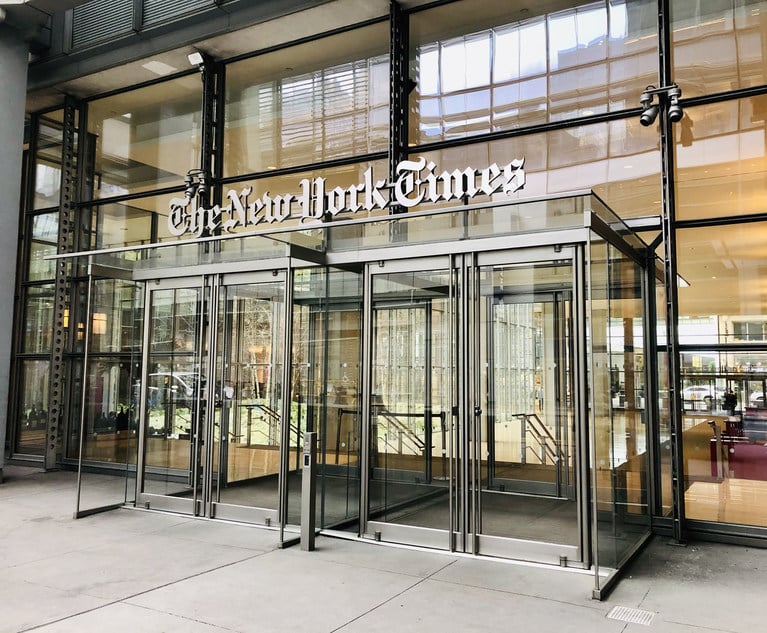Binder & Binder, Winding Down After Bankruptcy, to Lay Off 190 Employees
In state regulatory filings, the company said that it will lay off 100 employees from its Hauppauge, Long Island, headquarters and 90 employees from a Long Island City, Queens, plant that will close.
October 11, 2017 at 04:41 PM
5 minute read

Binder & Binder, a once-national company that advocates for claimants seeking Social Security disability benefits, intends to lay off 190 of its remaining 280 or so employees as it winds down pursuant to a Chapter 11 bankruptcy reorganization plan.
In state regulatory filings submitted in September, the company said it will lay off 100 employees from its Hauppauge, Long Island, headquarters and 90 employees from a Long Island City, Queens, plant that will close. The date of the layoffs is Dec. 11, according to the filings. The Long Island and Queens facilities are the last remaining sites for Binder & Binder—The National Social Security Disability Advocates LLC.
Fred Caruso, a senior managing director at Development Specialists Inc., a restructuring firm that is administering the wind-down plan for Binder & Binder, said Tuesday that the reorganization plan was confirmed by the Southern District of New York bankruptcy court in October 2016.
The company will eventually shut its doors under the plan, he said, but no final date is set. It will go out of business after it resolves the existing disability benefits claims it is still handling. Under the plan, the company stopped taking new cases, he said.
Before filing for bankruptcy in 2014, Binder & Binder had almost 1,000 employees in 35 offices across the country. Its estimated assets and liabilities were between $10 million and $50 million.
The company was handling more than 57,000 cases from disability claimants, and in the bankruptcy filing it asked for various forms of relief to keep paying its employees and continuing its cases.
In the 2013 fiscal year, the filing said Binder & Binder generated about $83.7 million in revenue, with more than 99 percent of the revenue coming from fees for Social Security and veterans cases.
The company noted that it does not collect revenue on a benefits case until it obtains a favorable decision. As a result, it said its cash flow was largely dependent on the rate at which the federal government adjudicated cases.
The federal government's sequestration and temporary shutdown in 2013 disrupted revenue flow and “contribut[ed] to the company's financial distress,” said Binder & Binder.
Another hurdle was the government's “more stringent standards” in weighing Social Security disability and veteran benefit cases in their early phases.
Caruso also said Tuesday that the company was in default of loan documents.

Binder & Binder, a once-national company that advocates for claimants seeking Social Security disability benefits, intends to lay off 190 of its remaining 280 or so employees as it winds down pursuant to a Chapter 11 bankruptcy reorganization plan.
In state regulatory filings submitted in September, the company said it will lay off 100 employees from its Hauppauge, Long Island, headquarters and 90 employees from a Long Island City, Queens, plant that will close. The date of the layoffs is Dec. 11, according to the filings. The Long Island and Queens facilities are the last remaining sites for Binder & Binder—The National Social Security Disability Advocates LLC.
Fred Caruso, a senior managing director at Development Specialists Inc., a restructuring firm that is administering the wind-down plan for Binder & Binder, said Tuesday that the reorganization plan was confirmed by the Southern District of
The company will eventually shut its doors under the plan, he said, but no final date is set. It will go out of business after it resolves the existing disability benefits claims it is still handling. Under the plan, the company stopped taking new cases, he said.
Before filing for bankruptcy in 2014, Binder & Binder had almost 1,000 employees in 35 offices across the country. Its estimated assets and liabilities were between $10 million and $50 million.
The company was handling more than 57,000 cases from disability claimants, and in the bankruptcy filing it asked for various forms of relief to keep paying its employees and continuing its cases.
In the 2013 fiscal year, the filing said Binder & Binder generated about $83.7 million in revenue, with more than 99 percent of the revenue coming from fees for Social Security and veterans cases.
The company noted that it does not collect revenue on a benefits case until it obtains a favorable decision. As a result, it said its cash flow was largely dependent on the rate at which the federal government adjudicated cases.
The federal government's sequestration and temporary shutdown in 2013 disrupted revenue flow and “contribut[ed] to the company's financial distress,” said Binder & Binder.
Another hurdle was the government's “more stringent standards” in weighing Social Security disability and veteran benefit cases in their early phases.
Caruso also said Tuesday that the company was in default of loan documents.
This content has been archived. It is available through our partners, LexisNexis® and Bloomberg Law.
To view this content, please continue to their sites.
Not a Lexis Subscriber?
Subscribe Now
Not a Bloomberg Law Subscriber?
Subscribe Now
NOT FOR REPRINT
© 2025 ALM Global, LLC, All Rights Reserved. Request academic re-use from www.copyright.com. All other uses, submit a request to [email protected]. For more information visit Asset & Logo Licensing.
You Might Like
View All
New York Times Moves for $100K in Attorney Fees Against Dfinity Foundation
3 minute read
Federal Judge Slaps Down the SEC’s Attempt to Regulate Crypto Liquidity Providers
10 minute read
A Client Is Guilty; But Another Man Is Wrongfully Convicted

Trending Stories
Who Got The Work
Michael G. Bongiorno, Andrew Scott Dulberg and Elizabeth E. Driscoll from Wilmer Cutler Pickering Hale and Dorr have stepped in to represent Symbotic Inc., an A.I.-enabled technology platform that focuses on increasing supply chain efficiency, and other defendants in a pending shareholder derivative lawsuit. The case, filed Oct. 2 in Massachusetts District Court by the Brown Law Firm on behalf of Stephen Austen, accuses certain officers and directors of misleading investors in regard to Symbotic's potential for margin growth by failing to disclose that the company was not equipped to timely deploy its systems or manage expenses through project delays. The case, assigned to U.S. District Judge Nathaniel M. Gorton, is 1:24-cv-12522, Austen v. Cohen et al.
Who Got The Work
Edmund Polubinski and Marie Killmond of Davis Polk & Wardwell have entered appearances for data platform software development company MongoDB and other defendants in a pending shareholder derivative lawsuit. The action, filed Oct. 7 in New York Southern District Court by the Brown Law Firm, accuses the company's directors and/or officers of falsely expressing confidence in the company’s restructuring of its sales incentive plan and downplaying the severity of decreases in its upfront commitments. The case is 1:24-cv-07594, Roy v. Ittycheria et al.
Who Got The Work
Amy O. Bruchs and Kurt F. Ellison of Michael Best & Friedrich have entered appearances for Epic Systems Corp. in a pending employment discrimination lawsuit. The suit was filed Sept. 7 in Wisconsin Western District Court by Levine Eisberner LLC and Siri & Glimstad on behalf of a project manager who claims that he was wrongfully terminated after applying for a religious exemption to the defendant's COVID-19 vaccine mandate. The case, assigned to U.S. Magistrate Judge Anita Marie Boor, is 3:24-cv-00630, Secker, Nathan v. Epic Systems Corporation.
Who Got The Work
David X. Sullivan, Thomas J. Finn and Gregory A. Hall from McCarter & English have entered appearances for Sunrun Installation Services in a pending civil rights lawsuit. The complaint was filed Sept. 4 in Connecticut District Court by attorney Robert M. Berke on behalf of former employee George Edward Steins, who was arrested and charged with employing an unregistered home improvement salesperson. The complaint alleges that had Sunrun informed the Connecticut Department of Consumer Protection that the plaintiff's employment had ended in 2017 and that he no longer held Sunrun's home improvement contractor license, he would not have been hit with charges, which were dismissed in May 2024. The case, assigned to U.S. District Judge Jeffrey A. Meyer, is 3:24-cv-01423, Steins v. Sunrun, Inc. et al.
Who Got The Work
Greenberg Traurig shareholder Joshua L. Raskin has entered an appearance for boohoo.com UK Ltd. in a pending patent infringement lawsuit. The suit, filed Sept. 3 in Texas Eastern District Court by Rozier Hardt McDonough on behalf of Alto Dynamics, asserts five patents related to an online shopping platform. The case, assigned to U.S. District Judge Rodney Gilstrap, is 2:24-cv-00719, Alto Dynamics, LLC v. boohoo.com UK Limited.
Featured Firms
Law Offices of Gary Martin Hays & Associates, P.C.
(470) 294-1674
Law Offices of Mark E. Salomone
(857) 444-6468
Smith & Hassler
(713) 739-1250






